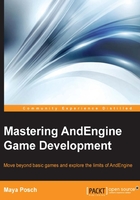
Dealing with the third dimension
The first question that is likely to come to mind when it is suggested to use 3D models in what is advertised as a 2D engine is whether or not this will make the game engine into a 3D engine. The brief answer here is "No."
The longer answer is that despite the presence of these models, the engine's camera and other features are not aware of this third dimension, and so they will not be able to deal with it. It's not unlike the ray-casting engine employed by titles such as Wolfenstein 3D, which always operated in a horizontal plane and, by default, was not capable of tilting the camera to look up or down. This does imply that AndEngine can be turned into a 3D engine if all of its classes are adapted to deal with another dimension.
We're not going that far here, however. All that we are interested in right now is integrating 3D model support into the existing framework. For this, we need a number of things. The most important one is to be able to load these models. The second is to render them in such a way that we can use them within the AndEngine framework.
As we explored earlier, the way of integrating 3D models into a 2D scene is by realizing that a model is just a very large collection of possible sprites. What we need is a camera so that we can orient it relative to the model, similar to how the camera in a 3D engine works. We can then display the model from the orientation.
Any further manipulations, such as scaling and scene-wide transformations, are performed on the model's camera configuration. The model is only manipulated to obtain a new orientation or frame of an animation.